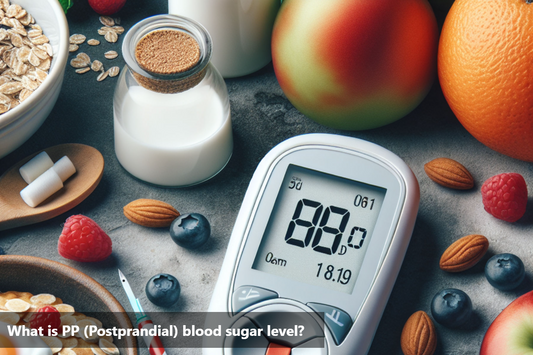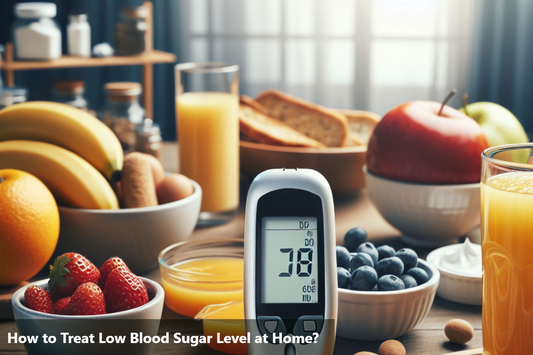As we learn about how our bodies work, blood sugar is a key piece of the puzzle. Blood sugar refers to the amount of glucose - or sugar - circulating in our bloodstream. Our cells use this glucose for energy.
Keeping blood sugar levels in a healthy range matters more than just hitting certain numbers. Balanced blood sugar helps our bodies hum along smoothly, like a well-tuned engine with just the right fuel. Staying in balance is important for feeling our best day-to-day.
Beyond helping us feel good now, healthy blood sugar helps avoid bigger issues down the road. If blood sugar stays too high over time, it can lead to diabetes, heart disease, and other complications. On the flip side, chronically low blood sugar can contribute to dizzy spells, confusion, and more hypoglycemia issues.
In the complex workings of our bodies, blood sugar plays a lead role. Normal blood sugar levels are typically measured in milligrams per deciliter (mg/dL) and can vary throughout the day, depending on factors such as when you last ate. Here are the general guidelines:
-
Fasting Blood Sugar (FBS):
Normal: Less than 100 mg/dL
Prediabetes (impaired fasting glucose): 100-125 mg/dL
Diabetes: 126 mg/dL or higher
Fasting blood sugar is measured after an overnight fast, usually in the morning before eating anything. It provides an indication of how well your body is managing glucose without the influence of recent meals.
-
Postprandial Blood Sugar (PPBS) or After-Meal Blood Sugar:
Normal: Less than 140 mg/dL
Prediabetes: 140-199 mg/dL
Diabetes: 200 mg/dL or higher
Postprandial blood sugar is measured 2 hours after eating. This level gives insights into how your body handles the glucose derived from food.
-
HbA1c (Glycated Hemoglobin):
Normal: Less than 5.7%
Prediabetes: 5.7% to 6.4%
Diabetes: 6.5% or higher
HbA1c provides an average of your blood sugar levels over the past 2-3 months. It is a useful indicator for long-term blood sugar control.
Maintaining blood sugar within these normal ranges helps reduce the risk of complications associated with diabetes, such as heart disease, kidney damage, nerve damage, and vision problems.
Normal Blood Sugar Range for Adults
Let's talk about what's normal for blood sugar levels in adults. There are two main measurements we look at: fasting blood sugar levels and postprandial levels, which are checked after meals.
Fasting Blood Sugar Levels: This test is done after not eating overnight, usually in the morning. A normal result is usually between 70 to 100 mg/dL. It's like a starting point that shows how well your body manages glucose during the fasting time.
-
Postprandial (After Meals) Levels: These levels are checked about two hours after eating to see how our bodies handle glucose from food. Ideally, these levels should be below 140 mg/dL. This means your body is efficiently processing and absorbing glucose after eating.
Age Group
Fasting Blood Sugar
Postprandial Blood Sugar
Children
70-100
Up to 140
Adults
70-100
Up to 140
Men
70-100
Up to 140
Women
70-100
Up to 140
Older Adults
70-100
Up to 140
It's important to understand these numbers. If your fasting or postprandial levels are consistently high, it might indicate a problem that needs attention. High fasting levels could suggest insulin resistance, while elevated postprandial levels may point to difficulties in managing glucose after eating.
Now, let's talk about the units used for measurement - milligrams per deciliter (mg/dL). This is the standard in the United States. Knowing this unit is important when looking at blood sugar test results. The target range for good health is generally between 70 to 100 mg/dL for fasting levels and below 140 mg/dL for postprandial levels.
Remember, these numbers are like a guide, showing us if everything is okay or if there might be a concern. Keeping your blood sugar within these recommended ranges is like giving your body the green light for optimal function. So, as we go on, keep these numbers in mind as important indicators of your overall health.
Factors Influencing Blood Sugar Levels
Now, let's break down the complex factors that affect our blood sugar levels and explore simple tips for keeping them steady.
Food: What we eat has a big impact on our blood sugar. Foods high in sugars and carbs can make levels spike, but a balanced diet with whole grains, lean proteins, and healthy fats keeps things stable. Controlling portion sizes is important to avoid too much glucose.
Exercise: Regular physical activity helps manage blood sugar. Exercise improves how cells absorb glucose, even simple activities like walking can help. Aim for at least 150 minutes of moderate exercise each week.
Stress: Stress affects our blood sugar. When stressed, the body releases hormones that raise blood sugar. Managing stress with techniques like deep breathing, meditation, or hobbies can help keep things balanced.
Health Conditions: Certain conditions, like diabetes, can directly affect blood sugar. It's crucial to manage these with the help of healthcare professionals. Regular check-ups and following prescribed medications help control blood sugar.
Practical Tips:
Meal Planning: Build meals with a mix of carbs, proteins, and fats to regulate the pace of glucose entering the bloodstream.
Regular Monitoring: Keep an eye on your blood sugar levels with regular testing, especially if you have health conditions or a family history of diabetes.
Hydration: Drinking enough water supports your body's functions, including blood sugar regulation.
Quality Sleep: Get enough good sleep to maintain hormonal balance and keep blood sugar in check.
Mindful Eating: Pay attention to when you're hungry or full. Avoiding unnecessary snacks and emotional eating helps maintain stable blood sugar.
By understanding and managing these factors, you can take control of your blood sugar levels. It's not about strict rules but adopting a holistic approach for your well-being. Keep these tips in mind as you make lifestyle choices affecting your blood sugar balance.
To Sum it up
Getting the Basics: We started by talking about how blood sugar levels are like the fuel for our body. Keeping these levels normal isn't just a number goal – it's an important investment in our long-term health.
Understanding Measurements: We looked at the two main ways to measure blood sugar – fasting levels and post-meal levels. Knowing the right ranges (70-100 mg/dL for fasting and under 140 mg/dL after eating) helps us understand if we're in good health.
Things that Affect Levels:: We explored things that can change our blood sugar levels, like what we eat, how active we are, stress, and any health issues we might have. We also shared practical tips, focusing on making smart choices for stability.
Taking Control with Lifestyle Choices: The main point is taking control. Checking your blood sugar regularly helps you be proactive and learn about how your body works. Changing your lifestyle, with a balanced diet, regular exercise, stress management, and good sleep, is a strong way to keep your blood sugar in check.
Getting Help from Professionals: While we figure this out together, it's important to remember that everyone's health journey is different. Talking to healthcare professionals gives you personalized advice based on your needs. Regular check-ups and honest talks with your healthcare team really help you manage your health well.
In summary, keeping normal blood sugar levels isn't the same for everyone. It's a team effort between you and your body, guided by awareness and smart choices. As you start on this journey, remember that small, steady steps toward a balanced lifestyle can bring big results.
So, here's to your health – to understanding, taking charge, and the pursuit of a life with balanced blood sugar levels and overall well-being. Cheers to the journey ahead!
This Blog post is an initiative by DiabeSmart, to provide accurate and Nutritionist / Doctor approved information related to Diabetes. DiabeSmart is India's first Food brand designed specifically for Diabetics, that has been clinically tested on Diabetics and Pre-Diabetics to deliver 55% - 70% lower Sugar spikes. DiabeSmart is part of Lo! Foods - India's leading brand for Everyday Functional Health foods.













